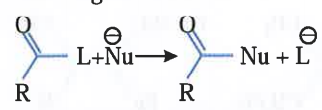Aldehyde, ketone, acid and acid derivatives contain >C=O group. Aldehyde and ketones gives nucleop addition reactions where as acid and acid derivatives gives nucleophilic addition followed by ellmination reaction Nucleophilic addition reactions followed by ellimination of acid derivatives is known as acyl substitution reacts This subsitution reaction takes places by formation of tertrahedral intermediate.
Which one of the following is least reactive compound for nucleophilic acyl substitution.
_E01_573_O01.png)
_E01_573_O02.png)
_E01_573_O03.png)
_E01_573_O04.png)
The correct Answer is:B
Topper's Solved these Questions
- ALKENE, ALKANE & ALKYNE Book:ALLENChapter:ALKENE, ALKANE & ALKYNE Exercise:EXERCISE-4(A)
Explore 10 Videos
- ALKENE, ALKANE & ALKYNE Book:ALLENChapter:ALKENE, ALKANE & ALKYNE Exercise:EXERCISE-4(B)
Explore 10 Videos
- ALKENE, ALKANE & ALKYNE Book:ALLENChapter:ALKENE, ALKANE & ALKYNE Exercise:EXERCISE-1
Explore 119 Videos
- AIIMS 2019Book:ALLENChapter:AIIMS 2019Exercise:CHEMISTRY
Explore 35 Videos
- ALKYL AND ARYL HALIDEBook:ALLENChapter:ALKYL AND ARYL HALIDEExercise:EXERCISE-05 (B)
Explore 37 Videos
Similar Questions
Aldehyde, ketone, acid and acid derivatives contain >C=O group. Aldehyde and ketones gives nucleop addition reactions where as acid and acid derivatives gives nucleophilic addition followed by ellmination reaction Nucleophilic addition reactions followed by ellimination of acid derivatives is known as acyl substitution reacts This subsitution reaction takes places by formation of tertrahedral intermediate.
Which of the following compounds has very poor leaving group?
View SolutionAldehyde, ketone, acid and acid derivatives contain >C=O group. Aldehyde and ketones gives nucleop addition reactions where as acid and acid derivatives gives nucleophilic addition followed by ellmination reaction Nucleophilic addition reactions followed by ellimination of acid derivatives is known as acyl substitution reacts This subsitution reaction takes places by formation of tertrahedral intermediate. For the given reaction
_E01_571_Q01.png)
which of these is correct?
View Solution
Knowledge Check
Aldehyde, ketone, acid and acid derivatives contain >C=O group. Aldehyde and ketones gives nucleop addition reactions where as acid and acid derivatives gives nucleophilic addition followed by ellmination reaction Nucleophilic addition reactions followed by ellimination of acid derivatives is known as acyl substitution reacts This subsitution reaction takes places by formation of tertrahedral intermediate.
Which of the following compounds has very poor leaving group?A_E01_572_O01.png) B
B_E01_572_O02.png) C
C_E01_572_O03.png) D
D_E01_572_O04.png)
Aldehyde, ketone, carboxylic acid derivatives contain C= O group. Aldehyde and ketones give nucleophilic addition reactions where as acid and acid derivatives give nucleophilic addition followed by elimination reactions. Nucleophilic addition reactions followed by elimination of acid dervatives is Known sacyl substitution reaction. This substitution reaction takes place by formation of tetrahedral intermediate. For the given reaction

which of these is correct ?AL must be better leaving group than NuBNu− must be strong enough nucleophile to attack carbonyl carbonCCarbonyl carbon must be enough electrophilic to react with Nu−Dall of theseWhich of the following is least reactive in a nucleophilic substitution reaction?
A(CH3)3C−ClBCH2=CHClCCH3CH2ClDCH2=CHCH2Cl
Aldehyde, ketone, acid and acid derivatives contain >C=O group. Aldehyde and ketones gives nucleop addition reactions where as acid and acid derivatives gives nucleophilic addition followed by ellmination reaction Nucleophilic addition reactions followed by ellimination of acid derivatives is known as acyl substitution reacts This subsitution reaction takes places by formation of tertrahedral intermediate. For the given reaction
_E01_571_Q01.png)
which of these is correct?
View SolutionWhich of the following is least reactive in a nucleophilic substitution reaction?
View SolutionKetones give nucleophilic addition reactions more readily than aldehydes.
View SolutionNucleophilic Addition Reaction Followed By Elimination Of H2o Addition Of Ammonia Derivatives
View SolutionWhich of the following compounds is most reactive towards nucleophilic addition reactions ?
View Solution
